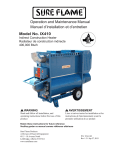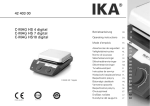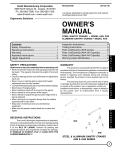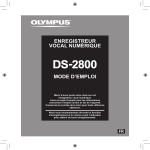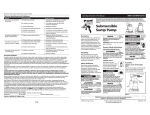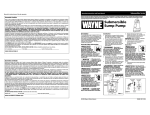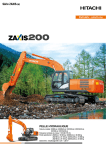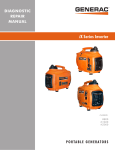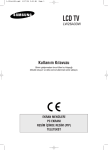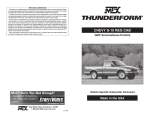Download Model No. IX800 Operation and Maintenance Manual
Transcript
Operation and Maintenance Manual Manuel d’installation et d’entretien Model No. IX800 Indirect Construction Heater Radiateur de construction indirecte 800,000 Btu/h WARNING Read and follow all installation, and operating instructions before first use of this product AVERTISSEMENT Lisez et suivez toutes les installation et les instructions de fonctionnement avant la première utilisation de ce produit Retain these instructions for future reference Veuillez garder ce manuel comme référence ultérieure Sure Flame Products A Divison of Haul-All Equipment 4115 - 18 Avenue North Lethbridge, Alberta T1H 5G1 www.sureflame.com P/N 974-4135 Rev 1.2 Sep 30, 2014 IX800 Operation & Service Manual GENERAL HAZARD WARNING Failure to comply with the precautions and instructions provided with this heater, can result in death, serious bodily injury and property loss or damage from hazards of fire, explosion, burn, asphyxiation, carbon monoxide poisoning, and/or electrical shock. Only persons who can understand and follow the instructions should use or service this heater. If you need assistance or heater information such as an instruction manual, labels, etc. Contact the manufacturer. WARNING Fire, burn, inhalation, and explosion hazard. Keep solid combustibles, such as building materials, paper or cardboard, a safe distance away from the heater as recommended by the instructions. Never use the heater in spaces which do or may contain volatile or airborne combustibles, or products such as gasoline, solvents, paint thinner, dust particles or unknown chemicals. WARNING Not for home or recreational vehicle use. MISES EN GARDE GÉNÉRALES Le non-respect des mises en garde et des instructions fournies avec ce radiateur peut entraîner la mort, de graves blessures et des pertes matérielles ou des dommages à la propriété résultant d’un incendie, d’une explosion, de brulures, d’asphyxie, d’empoisonnement au monoxyde de carbone et/ou d’un choc électrique. Seules les personnes aptes à comprendre et à suivre les instructions devraient se servir de ce radiateur ou le réparer. Si vous avez besoin d’aide ou d’informations concernant ce radiateur, soit une notice d’instructions, une étiquette, etc., prière de communiquer avec le fabricant. AVERTISSEMENT Risque d’incendie, de brûlures, d’inhalation et d’explosion. Garder les combustibles solides, tels les matériaux de construction, le papier et le carton, à bonne distance de ce radiateur, comme il est recommandé dans les instructions. Ne jamais utiliser cet appareil dans des endroits qui contiennent ou pourraient contenir des combustibles volatiles ou en suspension dans l’air tels l’essence, les solvants, les diluants pour peinture, les particules de poussières ou des produits chimiques inconnus. AVERTISSEMENT Ne pas utiliser dans une maison ou un véhicule de camping. 2 P/N 974-4135 Rev: 1.2 IX800 Operation & Service Manual Read this Warning First Lire cet avertissement en premier This heater is designed and approved for use as a construction heater under ANSI Z83.72011/CSA 2.14-2011. The primary purpose of construction heaters is to provide temporary heating of buildings under construction, alteration, or repair and to provide temporary emergency heat. Properly used, the heater provides safe economical heating. Since the products of combustion are released, it is imperative that the flue stack is extended outside of the enclosed area when the heater is positioned indoors. Le radiateur est conçu et approuvé aux fins d’utilisation comme radiateur de construction en conformité avec la norme ANSI Z83.7-2011/CSA 2.14-2011. La fonction principale des radiateurs de construction est de fournir un chauffage temporaire des bâtiments en construction, modification ou restauration, et de fournir de la chaleur en cas d’urgence. Correctement utilisé, le chauffage fournit de la chaleur de façon sûre et économique. Étant donné que les produits de combustion sont rejetés, il est impératif que le conduit d’évacuation mène à l’extérieur de l’espace clos lorsque le radiateur se trouve à l’intérieur. Ce radiateur n’est pas conçu comme chauffage au gaz sans ventilation pour pièce d’habitation selon la norme ANSI-Z21.11.2 et ne doit pas être utilisé à domicile. La norme ANSI A119.2 (NFPA 501C)-1987 concernant les véhicules de loisirs interdit l’installation ou l’entreposage de bouteilles de gaz LP/propane, même temporairement, à l’intérieur des véhicules de loisirs. La norme interdit également l’utilisation de chauffage sans ventilation dans de tels véhicules. L’installation doit être conforme aux codes locaux, ou en l’absence des codes locaux, au National Fuel Gas Code ANSI Z223.1/NFPA 54 et le Standard for the Storage and Handling of Liquified Petroleum Gases ANSI/NFPA 58. Au canada, toutés les autorties d’inspection des appareils à gaz exignt que l’installation des appareils de chauffage et de leurs accessres soit effectuée par des gaziers qualifiés. L’installation doit être conforme au code CSA B149.1 code d’installation du gaz naturel et du propane. Nous ne pouvons pas anticiper chaque utilisation qui pourrait être faite de nos radiateurs. VÉRIFIEZ AUPRÈS DE VOTRE AUTORITÉ LOCALE EN PRÉVENTION DES INCENDIES SI VOUS AVEZ DES QUESTIONS SUR LES RÉGLEMENTATIONS LOCALES. D’autres normes régissent l’utilisation des carburants gazeux et des produits générateurs de chaleur dans des applications spécifiques. Votre autorité locale peut vous en informer. This heater is not designed as an Unvented Gas Fired Room Heater under ANSI-Z21.11.2 and should not be used in the home. ANSI A119.2(NFPA 501C)-1987 Recreational Vehicle Standard prohibits the installation or storage of LP-Gas containers even temporarily inside any recreational vehicle. The standard also prohibits the use of Unvented Heaters in such vehicles. Installation must comply with local codes, or in the absence of local codes, with the National Fuel Gas Code ANSI Z223.1/ NFPA 54 and the Standard for the Storage and Handling of Liquified Petroleum Gases ANSI/NFPA 58. Gas inspection authorities in Canada require that the installation and maintenance of heaters and accessories be accomplished by qualified gas fitters. Installation must comply with local codes, and with the Natural Gas and Propane Installation Code CSA-B149.1. We cannot anticipate every use which may be made for our heaters. CHECK WITH YOUR LOCAL FIRE SAFETY AUTHORITY IF YOU HAVE QUESTIONS ABOUT LOCAL REGULATIONS. Other standards govern the use of fuel gases and heat producing products in specific applications. Your local authority can advise you about these P/N 974-4135 Rev: 1.2 3 IX800 Operation & Service Manual Table of Contents Specifications...................................................................................... 5 Installation........................................................................................... 6 Operating Instructions......................................................................... 11 Maintenance....................................................................................... 12 Troubleshooting Chart........................................................................ 16 Wiring Diagrams................................................................................. 28 Parts Diagrams................................................................................... 30 Table des matières Spécifications...................................................................................... 5 Installation........................................................................................... 6 Mode d’emploi.................................................................................... 11 Entretien............................................................................................. 12 Tableau de dépannage....................................................................... 16 Schémas de câblage.......................................................................... 28 Schémas de pièces............................................................................ 30 4 P/N 974-4135 Rev: 1.2 IX800 Operation & Service Manual SPECIFICATIONS Model No. IX800 Capacity / Capacite:800,000 Btu/h (235 kW) Gas/Gaz:Natural or Propane Inlet Pressure* / Pression d’arrive*: max 5 psi (34.5kPa) min 7” WC (1.74 kPa) Manifold Pressure / Pression du distributeur Natural Gas 3.9”WC (0.97 kPa) Propane 1.9”WC (0.47 kPa) Orifice Size / Calibre de l’injecteur: 0.581” Electrical Rating / Puissance Electrique: 208/230 Volts, 27.0/24.4A, 3Ph, 60Hz 208/230 Volts, 43.6/39.4A, 1Ph, 60Hz Minimum Temperature / température minimale: -40°C (-40°F) Duct Diameter / diamètre du conduit: 20” or 2 x 16” Maximum Duct Length: 100’ (30.5 m) VentingCategory I Fuel Consumption / consommation de carburant Natural Gas 800 ft³/hr Propane 318 ft³/hr Certification CSA 2.14-2011 * Minimum inlet pressure is for purpose of input adjustment * La pression minimum d’arrivée est en vue de l’ajustement de l’alimentation. P/N 974-4135 Rev: 1.2 5 IX800 Operation & Service Manual Installation Installation The Sure Flame Model IX800 is an indirect-fired gas heater intended to be used primarily for the temporary heating of buildings under construction, alteration or repair. Since the products of combustion are released, it is imperative that the flue stack is extended outside of the enclosed area when the heater is positioned indoors. The flow of supply air and exhaust gasses must not be obstructed in any manner. Le modèle Sure Flame IX est un radiateur au gaz à combustion indirecte prévu pour être utilisé principalement pour réchauffer temporairement un bâtiment en cours de construction, modification ou restauration. Étant donné que les produits de combustion sont rejetés, il est impératif que le conduit d’évacuation mène à l’extérieur de l’espace clos lorsque le radiateur se trouve à l’intérieur. L’écoulement d’air d’admission et des gaz de combustion ne doit en aucune façon être obstrué. The equipment shall be installed in accordance with the National Fuel Code, ANSI 223.1/NFPA 54, and/or the Natural Gas and Propane Installation Code CSA B149.1, and applicable local regulations, which should be carefully followed in all cases. Authorities having jurisdiction should be consulted before installations are made. The heater shall be used in a horizontal position on a firm, non-combustible surface. The electrical grounding of the appliance shall be in compliance with National Electrical Code, ANSI/NFPA 70, or the CSA C22.1, Canadian Electrical Code, Part I Warning: The installation and maintenance of the heater must be accomplished by a qualified service person. The heater should be inspected before each use and at least annually. Warning: Do not use this heater in a space where gasoline of other liquids with flammable vapours are stored or used. L’équipement doit être installé conformément à la National Fuel Code, ANSI 223.1/NFPA 54, et/ou la code d’installation du gaz naturel et du propane CSA B149.1, et aux règlements locaux applicables, qui devraient être respectés dans tous les cas. Les autorités compétentes devraient être consultées avant de procéder à l’installation. Le radiateur devrait être utilisé horizontalement sur une surface non combustible ferme. La mise électrique à la terre de l’appareil se fera conformément au National Electrical Code, ANSI/NFPA 70, ou le CSA C22.1, Code canadien de l’électricité, 1re partie. Avertissement : Installation et maintenance du radiateur doivent être effectuées par un agent de service qualifié. Le radiateur doit être inspecté avant chaque utilisation, et au moins une fois par an. Avertissement : Ne pas utiliser le radiateur dans un endroit où on entrepose ou utilise de l’essence ou d’autres liquides émanant des vapeurs inflammables. 6 P/N 974-4135 Rev: 1.2 IX800 Operation & Service Manual Clearances Dégagements Clearance required for combustibles: Outlet: 10 ft (3 m) Sides: 2 ft (0.6 m) Top: 3 ft (0.9 m) Flue: 18” (45 cm) Floor: Noncombustible Espace dégagé requis pour les combustibles: Sortie: 10 pi (3m) Cotes: 2 pi (0.6 m) Combustion: 18 po (45 cm) Dessus: 0.9 m Plancher: Noncombustible Minimum clearance required to LP Gas containers: Outlet: 20 ft (6.1 m) Top & Sides: 10 ft (3.0 m) Espace minimum requis pour les contenants de Gaz PL Sortie: 20 pi (6.1 m) Dessus et Cotes: 10 pi (3.0 m) Position heater properly on a horizontal surface before use. Placez le radiateur de façon appropriée, sur une surface horizontale, avant de l’utiliser. The hose assembly shall be protected from traffic, building materials and contact with hot surfaces both during use and while in storage. For use with or without ductwork. Only ductwork supplied by the manufacturer shall be used with this heater. For either indoor or outdoor use. Adequate ventilation must be provided. This heater is for operation at a temperature rise from 72°C to 120°C (162°F to 248°F). L’ensemble de flexibles devra être protégé de la circulation, des matériaux de construction et du contact avec des surfaces chaudes durant l’utilisation et durant l’entreposage. Pour utilisation avec ou sans réseau de gaines. Seulement réseau de gaines fourni par le fabricant sera utilisé avec cet radiateur. Pour utilisation à l’intérieur ou à l’extérieur. La ventilation doit être adéquate. Cet aérotherme fonctionne a une élévation de température de 72°C a 140°C (162°F a 248°F) All gas inspection authorities in Canada require that the installation and maintenance of heaters and accessories shall be accomplished by qualified gas fitters. Au canada, toutés les autorties d’inspection des appareils à gaz exignt que l’installation des appareils de chauffage et de leurs accessres soit effectuée par des gaziers qualifiés. Installation must comply with the Natural Gas and Propane Installation Code, CSA B149.1. L’installation doit être conforme au code CSA B149.1 code d’installation du gaz naturel et du propane. Ducting The IX800 can be ducted on both the inlet and outlet. The inlet duct can be up to 50’ of smooth 16” metal duct The outlet duct shall be of a material able to withstand temperatures of up to 300°F. Total outlet duct length may be up to 300’ of straight, smooth, 20” metal duct. Use of flexible ducts, smaller ducts, or bends in the ducts will reduce the allowable length and may result in excessive cycling of the burner. P/N 974-4135 Rev: 1.2 Conduits Le radiateur IX800 peut être canalisé à l’orifice d’entrée et de sortie. La canalisation d’entrée peut atteindre jusqu’à 50 pieds de conduits en métal lisse de 16 po. La canalisation de sortie sera fabriquée d’un matériau pouvant résister à des températures allant jusqu’à 300 °F. La longueur totale de la canalisation de sortie peut atteindre jusqu’à 300 pieds de conduits en métal lisse droits de 20 po. L’utilisation de conduites flexibles, de plus petites conduites ou de coudes dans la canalisation réduira la longueur permise et peut entraîner des fluctuations excessives du brûleur. 7 IX800 Operation & Service Manual Venting This equipment requires CLASS A venting to the exterior. The vent connector should be designed for a negative pressure and be constructed of materials having corrosion resistance and durability to heat at least equivalent to that of No. 24 GSG galvanized steel. Venting must comply with the Natural Gas and Propane Installation Code CSA B149.1, as well as other local regulations that may apply. Flue Diameter10”8” Min. vertical height 4’ 4’ Max. lateral length* 15’ 0’ Max. # of added elbows** 2 0 *Lateral lengths must have a minimum 10% rise. ** A minimum vertical length of 2’ is required before the first elbow and after the last elbow. Consult the manufacturer for additional venting options. Rated flue gas temperature 446°F (230°C) Rated vent pressure - Negative Category I Gas Connections Ensure the correct regulator is used to supply the heater with maximum inlet pressure of 5 psi. Excessive pressure will damage components and void the warranty. Visually inspect the fuel supply hose assembly. Ensure that it is protected from traffic, building materials, and contact with hot surfaces. Replace if there is evidence of excessive wear or abrasion. After installation, check for gas leaks by applying a soapy solution at each piping and hose assembly connection. 8 Ventilation Cet équipement exige une ventilation vers l’extérieur de type A. Le raccord d’évent devrait être conçu pour une pression négative et construit de matériaux ayant une résistance à la corrosion et une durabilité à la chaleur équivalant au moins à l’acier galvanisé no 24 GSG. La ventilation doit se conformer à la Norme concernant les Installations au gaz naturel et au propane CSA B149.1, ainsi qu’aux autres règlements locaux qui peuvent s’appliquer. Conduit d’évacuation 10 po 8 po Hauteur min. verticale 4 pi 4 pi Longueur max. latérale* 15 pi 0 pi Nombre max. de coudes**2 0 *Les longueurs latérales doivent avoir une inclinaison d’au moins 10 %. **Une longueur verticale d’au moins 2 pieds est requise avant le premier coude et après le dernier coude. Consulter le fabricant pour des options de ventilation supplémentaires. Temperature nominale du gaz de combustion 446°F (230°C) Pression nominale de l’event - Négative Catégorie I Raccords au gaz S’assurer que le régulateur approprié est utilisé pour fournir la pression d’admission maximale de 5 psi au radiateur. Une pression excessive endommagera les pièces et annulera la garantie. Inspecter visuellement l’ensemble du tuyau d’alimentation. S’assurer qu’il est protégé de la circulation, des matériaux de construction et du contact avec des surfaces chaudes. Le remplacer, s’il y a des signes d’usure ou d’abrasion excessive. Après l’installation, vérifier s’il ya des fuites de gaz en appliquant une solution savonneuse à chaque raccord de la canalisation. P/N 974-4135 Rev: 1.2 IX800 Operation & Service Manual INSTALLATION USING A PROPANE SUPPLY TANK 1 When installing the heater for use with propane gas, set the gas selector valve to “Propane” and lock in position. 2 Arrange the propane supply system to provide for vapour withdrawal from the operating container. Supplying liquid propane to the heater is dangerous and will damage the components. Another regulator must be installed on the heater to reduce the pressure from this regulator to a maximum inlet pressure of 5 psi. 3 Ensure that for the surrounding temperature the size and capacity of the propane supply container is adequate to provide the rated Btu/h input to the heater. 4 Turn off the propane supply valve at the container when the heater is not in use. 5 The installation must conform with local codes, or in the absence of local codes, with the Standard for the Storage and Handling of Liquedied Petroleum Gases, ANSI/NFPA 58 or the Natural Gas and Propane Installation Code CSA-B149.1. 6 When the heater is to be stored indoors the propane container must be disconnected from the heater and the container moved away and stored in accordance with the above national standards. INSTALLATION FOR NATURAL GAS APPLICATIONS 1 When installing the heater for use with natural gas, set the gas selector valve to the “Natural” position. 2 A regulator must be installed on the heater to ensure that the pressure to the heater does not exceed 1/2 psi inlet pressure. 3 The installation of this heater to a natural gas supply must conform with all applicable local codes, or in the absence of local codes, with the National Fuel Gas Code ANSI Z223.1/ NFPA 54 or the Natural Gas and Propane Installation Code CSA-B149.1. P/N 974-4135 Rev: 1.2 9 IX800 Operation & Service Manual IX410 Operation & Service Manual LPG - PROPANE FUEL VAPORIZATION RATE The following chart shows the amount of BTU's that various sizes of tanks will produce on the average at specific temperatures and regular atmospheric conditions. Tank Size Gallons (Pounds) 150 (600) 250 (1000) 500 (2000) 1000 (4000) Maximum intermittent withdrawal rate (BTU/hr) without tank frosting* if lowest outdoor temperature (average for 24 hours) reaches. +40 F. +30 F. +20 F. +10 F. 0 F. -10 F -20 F. -30 F. 214,900 187,900 161,800 148,000 134,700 132,400 108,800 107,100 288,100 251,800 216,800 198,400 180,600 177,400 145,800 143,500 478,800 418,600 360,400 329,700 300,100 294,800 242,300 238,600 852,800 745,600 641,900 587,200 534,500 525,400 431,600 425,000 * Frosting on the outside of the tank acts as an insulator, reducing the vaporization rate. MAXIMUM BTU CONTENT (PROPANE) The following table shows the maximum BTU's that a cylinder contains. CYLINDER SIZE BTU CONTENT 100 pound 2,159,100 250 gallon USA 22,922,500 500 gallon USA 45,845,000 1000 gallon USA 91,690,000 CAUTION: In extremely cold weather it is impossible to completely empty a propane cylinder. PRESSURE & FLOW EQUIVALENTS 1 Std. Atmosphere = 1" Water Column (W.C.) = 11" Water Column = 1 lb./sq. in. (psig) = 1" Mercury = 1 Std. Cubic Ft./Hr. = 1 BTU/Hr. = 10 14.73 lb./sq. in. = 0.58 oz./sq. in. = 0.4 lb./sq. in.= 27.71" W.C. = 0.49 psig = 2,500 BTU/Hr. = 0.2931 Watts 1.014 bar 2.49 millibar 27.39 millibar 0.0689 bar 33.86 millibar 0.02832 cu. m/hr. P/N 974-4135 Rev: 1.2 IX800 Operation & Service Manual Operating Instructions 1) Set GAS SELECTOR VALVE to gas being used. NOTE: The Selector Valve must be locked in position. 2) Ensure firing valve (manual valve nearest the burner) is in the “ON” position. 3) Connect Power: Use appropriate power supply as indicated by the ELECTRICAL RATING information. 4) Open gas supply. 5) Press and release START switch. START light will come on. Set thermostat to desired setting. Burner Blower will start after about 5-30 seconds. Flame will ignite after another 20 seconds. 6) Heater will switch between high flame and no flame as required to maintain the desired temperature. 7) To stop, press STOP switch and turn gas off. Burner blower will stop after about 20 seconds. Main blower will continue to cycle until heat exchanger has cooled. Mode d’emploi 1) Régler la VALVE DE GAS SELECTION selon le type de gaz utilisé. Á NOTER: La valve de sélection doit étre immobilisée a l’aide du dispositif de verrouillage fourni a cet effet. 2) S’assurer que la valve d’allumage (valve manuelle la plus proche du brûleur) est dans la position “ON”. 3) Brancher le circuit électrique - se servir dùne source làlimentation équivalente à la PUISSANCE ELECTRIQUE indiquée ci-haut. 4) Ouvrir l’alimentation de gaz. 5) Enfoncer et relâcher le sélecteur START. Le témoin START sàllumera. Régler le thermostat à la température désirée. La flamme s`àllumera 20 secondes plus tard. 6) Le radiateur commutera entre flamme haute et flamme absente, selon les besoins, pour maintenir la température sélectionnée. 7) Pour éteindre, enfoncer STOP et couper le gaz. La soufflante s`àrrêtera enfoncer stop et couper le gaz. La soufflante s`arrêtera envirn 20 secondes plus tard. La soufflante principale continuera de cycler jusqu`àl`échangeur de chaleur se retroidit. P/N 974-4135 Rev: 1.2 11 IX800 Operation & Service Manual Maintenance Warning: Disconnect gas and electrical supplies before servicing. Weekly: Gas Hose Air flow Bearings Check for cracks and damaged connectors Remove any obstructions to air flow Lubricate bearings according to details below Monthly: Cords and Connectors Check for cracks, exposed wires, and dirt in electrical connectors Physical Integrity Check for damage to body, louvers, and inlet screens that may obstruct air flow and impact combustion quality Belts Replace belt if cracked or worn according to details below. Ensure belt tensioner is in place and tensioner roller is running smoothly. End of Season: Combustion Chamber Remove burner assembly Clean inside of combustion chamber with a wire brush. Vacuum all ash and soot from combustion chamber. Inspect combustion chamber for any damage. Do not use a heater that has a hole in the combustion chamber. Burner Remove burner from burner assembly Clean flame rod and igniter with solvent or emery cloth. Inspect for cracked ceramic. Ensure they are properly centered in the burner openings. Inspect wires for cracks or evidence of overheating Ensure burner head screws are tight. Ensure openings in orifice plate (located inside the burner pipe) are not blocked. Ensure gasket and door seal are in place and not damaged. Electrical components Check all wiring for loose, cracked, or overheated wires and connectors. Replace if necessary. Ensure ground wires are properly connected. Ensure control box seal is in place and not damaged. Wipe dirt from motors. Motors have sealed bearings and do not require lubrication. Valve Train Verify that manifold pressure matches the specification label. Adjust regulator pressure if necessary. Inspect strainer and clean if necessary. Using soapy water or gas leak detector, check all gas connections for leaks. Impellers Remove any dirt build-up on both burner and blower impellers. Inspect impellers for loose or damaged fins. Run heater and check for vibration. Replace impellers that are damaged or causing vibration. Body Ensure all panels and shields are in place and that fasteners are tight. 12 P/N 974-4135 Rev: 1.2 IX800 Operation & Service Manual Entretien Avertissement : Débrancher les alimentations en gaz et en électricité avant d’effectuer l’entretien. Toutes les semaines : Tuyaux de gaz Vérifier s’il y a des fissures et des raccords endommagés Débit d’air Retirer les obstructions à la circulation de l’air Tous les mois : Cordons et connecteurs Vérifier s’il y a des fissures, des câbles à découvert et de la saleté dans les connecteurs électriques Intégrité physique Vérifier s’il y a des dommages au corps, aux louvres et grilles d’entrée qui peuvent entraver la circulation de l’air et avoir une incidence sur la qualité de la combustion Courroie Remplacer la courroie si elle est fendue ou usée. S’assurer que le tendeur de courroie est en place et que le rouleau tendeur fonctionne en douceur. Fin de la saison : Chambre de combustion Retirer l’ensemble de brûleur. Nettoyer l’intérieur de la chambre de combustion à l’aide d’une brosse métallique. Enlever toute les cendres et la suie de la chambre de combustion à l’aide d’un aspirateur. Vérifier s’il y a des dommages à la chambre de combustion. Ne pas utiliser un radiateur ayant un trou dans la chambre de combustion. Brûleur Retirer le brûleur de l’ensemble de brûleur. Nettoyer l’électrode de détection de flamme et l’allumeur avec un solvant ou une toile d’émeri. Vérifier s’il y a des fissures dans la céramique. S’assurer qu’ils sont bien centrés dans l’ouverture du brûleur. Vérifier s’il y a des fissures ou des signes d’excès de chaleur dans les câbles. S’assurer que les vis de la tête de brûleur sont serrées. S’assurer que les ouvertures de la plaque à orifice (située à l’intérieur du tuyau du brûleur) ne sont pas bloquées. S’assurer que le joint d’étanchéité et le joint d’étanchéité de la porte sont en place et ne sont pas endommagés. Éléments électriques Vérifier s’il y a des câbles et des connecteurs desserrés, fissurés ou ayant des signes d’excès de chaleur. Les remplacer, au besoin. S’assurer que les fils de mise à la terre sont bien raccordés. S’assurer que le joint d’étanchéité de la boîte des commandes est en place et n’est pas endommagé. Essuyer la saleté des moteurs. Les moteurs ont des coussinets scellés. Ils n’exigent pas de lubrification. Organes de distribution Vérifier que la pression de la rampe à gaz correspond à celle inscrite sur l’étiquette de spécifications. Régler la pression du régulateur, au besoin. Inspecter la crépine et la nettoyer, au besoin. À l’aide d’eau savonneuse ou d’un détecteur de fuite de gaz, vérifier s’il y a des fuites au niveau des raccords au gaz. Rouets centrifuges Enlever l’accumulation de saleté sur le brûleur et les rouets centrifuges du ventilateur. Vérifier si les pales des rouets centrifuges sont desserrées ou endommagées. Faire fonctionner le radiateur et vérifier s’il y a des vibrations. Remplacer les rouets centrifuges qui sont endommagés ou qui causent des vibrations. Corps S’assurer que tous les panneaux et tous les écrans sont en place et que les attaches sont bien serrées. P/N 974-4135 Rev: 1.2 13 IX800 Operation & Service Manual Lubricating Bearings: Warning: Disconnect power before servicing bearings. The main blower has two bearings. They need to be periodically lubricated according to the schedule below. Some situations may require a change in lubricating periods as dictated by experience. Generally, a lower quantity of grease at frequent intervals is more effective than a greater quantity at extended lubrication intervals. Select a grease that is compatible with a lithium or lithium complex grease. Recommended Lubrication Schedule Lubrication Interval in Weeks Hours Run Per Day Main Blower (2.7 gram per bearing) 8 16 24 5 2 1 Storage: If equipment will be idle for some time, before shutting down, add compatible grease to the bearing until grease purges from the seals. This will ensure protection of the bearing, particularly when exposed to severe environmental conditions. After storage period, add fresh grease to the bearings before starting. Replacing Belts: Warning: Disconnect power before servicing belts. The main blower uses a double belt transmission. It requires the belts to be paired, and both need to be changed at the same time. Ensure that the blower belt tensioner is in place and set at 25°-30°, and that the tensioner roller is running smoothly. Replace if worn. Adjusting Manifold Pressure: Connect manometer to the port on the inlet flange of the regulator. While heater is operating, verify that the inlet pressure is between 7” WC and 5 psi. Connect manometer to manifold pressure tap on burner gas supply line. Ensure that the gas selector valve is set to the proper fuel. While the heater is operating check the manifold pressure. If the manifold pressure differs from specifications, re-adjust. The adjusting screw is located on side of regulator valve. Use 2.5mm Allen wrench. Remove the manometer and securely tighten the manifold pressure tap. 14 P/N 974-4135 Rev: 1.2 IX800 Operation & Service Manual SETTING FAN LIMIT SWITCHES The fan limit switch is factory set and should not normally need to be adjusted. If it is out of adjustment, follow these procedures: To set pointers, hold dial securely with one hand and move the pointers with the other hand using “limit stop tool”. Do not force the pointers past any stops on the dial even though the dial may be graduated beyond the stops. Top Limit Move the right hand pointer so that its high side of lever indicates 200°F. Top Fan Move the “Fan On” pointer so that its high side of lever indicates 100°F. This is the temperature at which the blower will start. Move the “Fan Off” pointer so that its high side of lever indicates 90°F. This is the temperature at which the blower will stop. Side Limit Move the right hand pointer so that its high side of lever indicates 250°F. Side Fan Move the “Fan On” pointer so that its high side of lever indicates 100°F. This is the temperature at which the blower will start. Move the “Fan Off” pointer so that its high side of lever indicates 90°F. This is the temperature at which the blower will stop. RÉGLAGE DU CADRAN Le commutateur de limite du ventilateur est réglée en usine et ne devrait normalement pas besoin d’être ajustés. Si elle est hors d’ajustement, suivez ces procédures: Pour régler les repères, maintenir le cadran fermement en place avec une main et déplacer les repères avec “limiteur butée outil”. Ne pas forcer les repères au-delà des butées du cadran, même s’il y a des graduations sur le cadran au-delà des butées. Limite Déplacer le repère droit pour que son bord droit indique 200°F pour le haut commutateur de limite et 250°F pour le commutateur de limite côté. Ventilateur Déplacer le repère central de marche du ventilateur (Fan On) pour que son bord droit indique 100°F. Déplacer le repère gauche d’arrêt du ventilateur (Fan Off) pour que son bord droit indique 90°F. C’est le température qui le ventilateur sera arrêté. POUR DÉGAGER LA BUTÉE, INSÉRER UN FIL RIGIDE DANS LE TROU LIMITEUR BUTÉE OUTIL PLAQUE GRADUÉE BUTÉE RÉGLABLE DU LIMITEUR INDICATEURD’ARRÉT DU VENTILATEUR INDICATEUR DE MARCHE DU VENTILATEUR THIS IS A “SAFETY STOP”. DO NOT ALTER HIGH SIDE OF LEVERS INDICATE TEMPERATURE SETTINGS P/N 974-4135 Rev: 1.2 INDICATEUR DU LIMITEUR (RÉGLÉ EN USINE A 200°F) IL SAGIT D’UNE BUTÉE DE SÉCURITÉ, NE PAS DÉPLACER LA LECTURE S’EFFECTURE À LA CÔTÉ HAUT DE L’INDICATEUR 15 IX800 Operation & Service Manual Troubleshooting The troubleshooting section has been divided in to five tables. Choose the appropriate table from the list below: Chart A – Burner blower does not start, No spark, No Flame, Chart B – Burner blower starts, No spark, No flame, Chart C – Burner blower starts, Spark, No flame, Chart D – Burner blower starts, Spark, Flame goes out after four seconds Chart F – Other problems during operations 16 P/N 974-4135 Rev: 1.2 IX800 Operation & Service Manual Heater Troubleshooting Symptom Possible Problems Ignition controller error light on steady. Ignition controller failure. Error Light Burner blower does not start, no spark, no flame Steady Green light is on. Single flash of the error light Air switch failure. on ignition controller after 30 seconds. Burner motor failure. 1 Burner won’t start when call for heat or jumper Low voltage fuse (T5A) burned out plug in. No green light but main blower turns Fuse (3A) burned out. on if fan manual button is pushed in. Power at Power transformer burned out. the VFD. - Control box electric heater always on. Control box cooling fan always on. Preheat thermostat failure. - Preheat relay (1) failure. - Green light always on. Heater stuck on standby. Preheat relay (2) failure. - Green light on. Orange light on. Control box cooling fan doesn’t work. Heater stuck on standby. Preheat relay (1) failure. - Green light on. Orange light on. Control box cooling fan on. Heater stuck in standby. Preheat relay (1) failure. - Preheat relay (2) failure. - Electric preheating element failure. - Green light is on when the start button is pressed, but turns off when the button is released. Logic relay failure. - Stop switch failure. - Green light is on. No error light on ignition controller. Thermostat failure. - No green light when start button is pressed. No power at the VFD. L2/L3 3 phase or L/N 1 phase contact on power selector switch failure. - No electrical supply. - L1/L2 3 phase or L/N 1 phase missing. - L2/L3 3 phase or L/N 1 phase fuse blown. - No green light when the start button is pressed. Green light comes on when the manual button on the logic relay is pressed. Start switch failure. - T5A fuse repeatedly burning out. Overload (or short) in 24VAC circuit (secondary transformer voltage). - Heater operates on 1 phase or 3 phase only. Power switch locked in one position. - P/N 974-4135 Rev: 1.2 1 - 17 IX800 Operation & Service Manual Burner blower starts, no spark, no flame Possible Problems Single error light flash on ignition controller after 30 seconds. Air switch failure. 1 Air switch set to too high a pressure. 1 Air tubes plugged or installed in wrong air switch position. 1 Burner motor won’t turn on if any draft is present. One error flash on ignition controller. Air switch set to too low a pressure. 1 Burner motor runs from power up. When start button is pushed green light is on and one error flash on ignition controller. Ignition controller failure. (Ignition controller F1 terminal powered.) 1 Burner motor relay failure. 1 No spark after 30 seconds prepurge (no visible arcing). Three error flashes on ignition controller. Burner motor shuts down after 45 seconds of postpurge. Ignition transformer failure. 3 Igniter shorting to ground. 3 Cracked spark plug ceramic insulator. 3 Error Light Symptom Burner blower starts, spark, no flame Possible Problems Burner motor starts but no flame after 30 seconds prepurge. Three error flashes on ignition controller. Output limit switch failure. 3 Top fan/limit switch failure. 3 Tilt switch failure. 3 Flame rod and spark plug wires reversed. 3 Manual valve closed. 3 Solenoid valve failure. 3 Upstream regulators installed backwards. 3 Inlet pressure too high. 3 Error Light Symptom Burner won’t ignite or occasionally Strainer plugged or dirty. ignites with poor combustion. Three error Manifold pressure set too low. flashes on ignition controller. Burner orifices plugged or dirty. Burner air inlet obstructed. 18 3 3 3 1 P/N 974-4135 Rev: 1.2 IX800 Operation & Service Manual Burner blower starts, spark, flame goes out after four seconds Possible Problems Three error flashes on ignition controller. Flame turns off after 4 sec TFI. Bent flame rod. 3 Wet flame rod. 3 Cracked flame rod ceramic insulator. 3 Burner not grounded. 3 Ignition controller failure. 3 Symptom Possible Problems Error code on the VFD. Contact manufacturer. Burner starts but main blower motor can’t accelerate to full RPM (hamming noise & excessive amperage draw). VFD trips during blower motor acceleration. Heater starts but shuts off when main blower motor starts. VFD failure. Error Light Malfunctioning main blower Error Light Symptom Low voltage (long extension cord, low cord gauge or too many items on circuit). Poor quality power (such as from a generator). Improper voltage. Incorrect VFD frequency setting. Main blower motor failure. - Broken belt. Motor connected in reverse. Main blower motor can’t accelerate to full Belt too tight. RPM. VFD trips off during blower motor acceleration. Vibration in main blower. Bearings seized. Contact manufacturer. Main blower motor never starts. Three Preheat relay (2) failure. error flashes on ignition controller. Excessive noise or vibration. Damaged or unbalanced main blower impeller. When cooling, main blower works in Side fan/limit switch failure. short burst cycles. Squeak noise during main blower motor Loose belt. start up. Noisy main blower operation. Vibrations in main blower. - Incorrect motor RPM. Main blower motor won’t turn (VFD works) or noisy. VFD trips. Main blower motor won’t turn if manual pushbutton is pushed in. Motor starts, but little or no air flow. P/N 974-4135 Rev: 1.2 - 3 - 19 IX800 Operation & Service Manual Other problems during operation Possible Problems Main blower fan takes a long time to start. Possible exchanger damage. Burner turns off shortly after it’s turned on. Burner turns off frequently. Control box cooling fan is always running. Average temperature in control box low. Control box cooling fan never starts. If in a warm environment, VFD may overheat and fail. Top fan/limit switch failure. - Side fan/limit switch failure. - Control box cooling fan limit switch failure. Control box cooling fan limit switch failure. Control box cooling fan burned out. Heater connected to liquid propane supply. Manifold pressure set too high. Changeover valve set to natural gas when connected to propane. L1 3 phase missing. L1 fuse blown. L1 contact on power selector switch failure. Preheat relay (2) failure. - Start switch failure. Stop switch failure. Preheat limit switch failure. - Green light burned out. - Preheat limit switch failure. Gas hose too small, too long, or blocked. 3 Preheat relay (2) failure. Thermostat failure. - Excessive yellow flame. Burner rumbling. Main blower fan starts then shortly after, supply panel breaker trips. Green light on. Orange light and heater turn on and off sporadically. Heater does not stop when the stop button is pressed. Heater operates normally. Average temperature in control box lower. VFD susceptible to fail while operating at a low temperature. Heater operates normally. Green power light off. Heater operates normally. No preheating. Heater shuts off or heater ignites but shuts off after awhile. Three error flashes on ignition controller. Heater starts immediately in cold weather. Heater does not turn off when the thermostat is turned to minimum. No error light on ignition controller. 20 Error Light Symptom - P/N 974-4135 Rev: 1.2 IX800 Operation & Service Manual Inlet pressure drops under 7”. Valve train pressure below nominal value. Heater ignites but shuts off after awhile. Three error flashes on ignition controller. Burner cycles on and off frequently. Low power output. Excessive CO from exhaust. Noise and/or vibration in burner blower. Poor combustion. Burner turns off. One error flash on ignition controller. Orange light always off. Propane tank too small to vaporize fast enough or tank freezes. Low inlet pressure. 3 Ducts too long, too small, or obstructed. Changeover valve set to propane when connected to natural gas. Damaged or unbalanced burner blower impeller. - Preheat relay (1) failure. Orange light burned out. Orange light always on. Preheat relay (1) failure. Heater runs very hot. Both output limit switch and side fan/limit switch fail to operate. Heater does not turn off when thermostat Solenoid valve leaks. turned to minimum. Two error flashes on the Solenoid valve installed ignition controller. backwards. Solenoid valve stuck open. Heater starts normally. Doesn’t cycle with long Side fan/limit switch failure. ducts. Shuts down with three error flashes on the ignition controller module. P/N 974-4135 Rev: 1.2 3 1 Y 2 2 2 3 21 IX800 Operation & Service Manual Tableau de dépannage Le ventilateur du brûleur ne s’allume pas, aucune étincelle, aucune flamme Problème possibles Témoin d’erreur solide sur la commande d’allumage. Témoin vert allumé. Clignotement simple du témoin d’erreur sur la commande d’allumage après 30 secondes. Défaillance de la commande Solide d’allumage Défaillance du commutateur de 1 débit d’air. Défaillance du moteur du brûleur. 1 Le fusible à faible tension (T5A) a sauté. Le fusible (3A) a sauté. Le transformateur d’alimentation a sauté. Le brûleur ne démarre pas lorsque le thermostat ou la prise volante sont branchés. Le témoin vert est éteint, mais le ventilateur principal se met en marche si on appuie sur le bouton manuel du ventilateur. Courant électrique au niveau du variateur de puissance. Le radiateur électrique de la boîte des commandes est toujours en marche. Le ventilateur de la boîte des commandes est toujours en marche. Témoin d’erreur Symptôme Défaillance du thermostat de préchauffage. Défaillance du relais (1) de préchauffage. Défaillance du relais (2) de préchauffage. Défaillance du relais (1) de préchauffage. - Défaillance du relais (1) de préchauffage. Défaillance du relais (2) de préchauffage. Défaillance de l’élément de préchauffage électrique. Le témoin vert s’allume lorsqu’on appuie sur Défaillance du relais logique. le bouton de mise en marche, mais s’éteint Défaillance de l’interrupteur lorsqu’on le relâche. d’arrêt. Témoin vert allumé. Aucun témoin d’erreur sur Défaillance du thermostat. la commande d’allumage. - Le témoin vert est toujours allumé. Le radiateur est coincé à la position veille. Le témoin vert est allumé. Le témoin orange est allumé. Le ventilateur de la boîte des commandes ne fonctionne pas. Le radiateur est coincé à la position veille. Le témoin vert est allumé. Le témoin orange est allumé. Le ventilateur de la boîte des commandes fonctionne. Le radiateur est coincé à la position veille. 22 - - P/N 974-4135 Rev: 1.2 IX800 Operation & Service Manual Le témoin vert reste éteint lorsqu’on appuie sur le bouton démarrer. Il y a du courant électrique au niveau du variateur de puissance. Aucun témoin vert lorsqu’on appuie sur le bouton de mise en marche. Le témoin vert s’allume lorsqu’on appuie sur le bouton de relais logique. Le fusible T5A s’éteint à maintes reprises. Le radiateur fonctionne sur 1 phase ou 3 phases uniquement. Contact à la phase L2/L3 3 ou la phase L/N 1 pendant la défaillance du commutateur d’alimentation. Aucune alimentation électrique. Absence de la phase L1/L2 3 ou la phase L/N 1. Le fusible de la phase L2/L3 3 ou de la phase L/N 1 a sauté. Défaillance de l’interrupteur de démarrage. - Surcharge (ou pénurie) dans le circuit 24VAC (tension d’un transformateur secondaire). L’interrupteur d’alimentation est verrouillé dans une position. - - - Le ventilateur du brûleur s’allume, aucune étincelle, aucune flamme Problème possibles Clignotement simple du témoin d’erreur sur la commande d’allumage après 30 secondes. Défaillance du commutateur de débit d’air. Le commutateur de débit d’air est réglé à une trop haute pression. Les conduits d’air sont bouchés ou insérés à la mauvaise position du commutateur de débit d’air. Le commutateur de débit d’air est réglé à une trop faible pression. 1 Défaillance de la commande d’allumage. (La commande d’allumage F1 est alimentée par la borne.) Défaillance du relais du moteur du brûleur. Défaillance de la commande d’allumage. Court-circuit de l’allumeur au sol. L’isolateur en céramique de la bougie d’allumage est craqué. 1 Le moteur du brûleur ne s’allume pas s’il y a un courant d’air. Clignotement simple du témoin d’erreur sur la commande d’allumage. Le moteur du brûleur fonctionne dès le démarrage. Lorsqu’on appuie sur le bouton de démarrage, le témoin vert s’allume et le témoin d’erreur sur la commande d’allumage clignote une fois. Il n’y a pas d’étincelle après la prépurge de 30 secondes (aucune production d’étincelle visible). Le témoin d’erreur de la commande d’allumage clignote trois fois. Le brûleur s’arrête après une post-purge de 45 secondes. P/N 974-4135 Rev: 1.2 Témoin d’erreur Symptôme 1 1 1 1 3 3 3 23 IX800 Operation & Service Manual Le ventilateur du brûleur s’allume, étincelle, aucune flamme Problème possibles Témoin d’erreur Symptôme Le moteur du brûleur démarre, mais il n’y a pas de flamme après la prépurge de 30 secondes. Le témoin d’erreur de la commande d’allumage clignote trois fois. Défaillance de l’interrupteur de fin de course de la sortie. Défaillance de l’interrupteur de fin de course/du ventilateur principal. Défaillance de l’interrupteur à bascule. Fils de l’électrode de detection de flamme et de la bougie d’allumage inversés. Valve manuel fermée. Défaillance de la vanne électromagnétique. Les régulateurs en amont ont été installés à l’envers. La pression d’admission est trop élevée. Le brûleur ne s’allume pas ou s’allume Crépine bouchée ou sale. parfois avec une mauvaise combustion. Pression de la rampe à gaz trop faible. Le témoin d’erreur de la commande Orifices du brûleur bouchés ou sales. d’allumage clignote trois fois. Admission d’air du brûleur obstrué. 3 3 3 3 3 3 3 3 3 3 3 1 Le brûleur s’allume, mais la flamme s’éteint après environ quatre secondes Problème possibles Le témoin d’erreur de la commande d’allumage clignote trois fois. L’électrode de détection de flamme est pliée. Électrode de détection de flamme mouillée. L’isolateur en céramique de l’électrode de détection de flamme est craqué. Le brûleur n’est pas mis à la terre. Défaillance de la commande d’allumage. 24 Témoin d’erreur Symptôme 3 3 3 3 3 P/N 974-4135 Rev: 1.2 IX800 Operation & Service Manual Symptôme Problème possibles Code d’erreur sur le variateur de fréquence. Communiquer avec le fabricant. Le brûleur se met en marche, mais le moteur du ventilateur principal ne peut pas accélérer à plein régime (bruit et courant tiré excessif). Le variateur de fréquence se déclenche pendant l’accélération du moteur du ventilateur. Le radiateur se met en marche, mais s’arrête lorsque le moteur du ventilateur principal se met en marche. Défaillance du variateur de fréquence. Faible tension (longue rallonge électrique, jauge du câble trop petit or trop d’articles sur le circuit). Puissance de faible qualité (comme celle provenant d’une génératrice). Mauvaise tension. Paramètres incorrects du variateur de fréquence. Défaillance du moteur à soufflerie principal. Tr/min du moteur incorrects. Le moteur du ventilateur principal ne se met pas en marche (le variateur de fréquence fonctionne) ou est bruyant. Le variateur de fréquence se déclenche. Le moteur du ventilateur principal ne se met pas en marche si on appuie sur le bouton manuel. Le moteur à soufflerie démarre, avec peu or pas de circulation d’air. Le moteur du ventilateur principal ne peut pas accélérer à plein régime. Le variateur de fréquence se déclenche pendant l’accélération du moteur du ventilateur. Il y a de la vibration dans le ventilateur principal. Communiquer avec le fabricant. Le moteur du ventilateur principal ne se met jamais en marche. Le témoin d’erreur de la commande d’allumage clignote trois fois. Bruit ou vibration excessifs. Pendant le refroidissement, le ventilateur principal fonctionne en cycles courts. Bruit aigu pendant le démarrage du moteur du ventilateur principal. Fonctionnement bruyant du ventilateur principal. Il y a des vibrations dans le ventilateur principal. P/N 974-4135 Rev: 1.2 Témoin d’erreur Le brûleur s’allume, mais le ventilateur principal ne démarre pas - - Courroie fendue. Moteur branché à l’inverse. Courroie trop serrée. - Les roulements sont grippés. - Défaillance du relais (2) de préchauffage. 3 Rouet centrifuge du ventilateur principal endommagé ou non équilibré. Défaillance de l’interrupteur de fin de course/du ventilateur latéral. Courroie desserrée. - 25 IX800 Operation & Service Manual Le ventilateur principal prend beaucoup de temps à se mettre en marche. Dommages possibles à l’échangeur. Le brûleur s’arrête peu de temps après être allumé. Le brûleur s’arrête fréquemment. Le ventilateur de la boîte des commandes est toujours en marche. La température moyenne de la boîte des commandes est basse. Le ventilateur de la boîte des commandes ne se met jamais en marche. Si l’appareil se trouve dans un milieu chaud, le variateur de fréquence peut surchauffer et faire défaut. Flamme jaune excessive. Grondement du brûleur. Le ventilateur soufflant principal se met en marche et, peu après, le disjoncteur du tableau de distribution se déclenche. Le témoin vert est allumé. Le témoin orange et le radiateur s’allument et s’éteignent de manière sporadique. Le radiateur ne s’arrête pas lorsqu’on appuie sur le bouton d’arrêt. Le radiateur fonctionne normalement. La température moyenne de la boîte des commandes est plus basse. Le variateur de fréquence est susceptible de faire défaut pendant le fonctionnement à une basse température. Le radiateur fonctionne normalement. Le voyant d’alimentation vert est éteint. Le radiateur fonctionne normalement. Aucun préchauffage. 26 Témoin d’erreur Autres problems pendant le fonctionnement Symptôme Problème possibles Défaillance de l’interrupteur de fin de course/du ventilateur du dessus. - Défaillance de l’interrupteur de fin de course/du ventilateur latéral. Défaillance de l’interrupteur de fin de course du ventilateur de la boîte des commandes. Défaillance de l’interrupteur de fin de course du ventilateur de la boîte des commandes. Défaillance du ventilateur de la boîte des commandes. Radiateur branché à l’alimentation au propane liquide. Pression de la rampe à gaz trop élevée. La valve de sélection du gaz est réglée au gaz naturel alors que l’appareil est branché au propane. Absence de la phase L1 3 Le fusible L1 a sauté. Défaillance de l’interrupteur d’alimentation. Défaillance du relais (2) de préchauffage. - Défaillance de l’interrupteur de démarrage. Défaillance de l’interrupteur d’arrêt. Défaillance du commutateur de préchauffage. - Défaillance du témoin vert. - Défaillance du commutateur de préchauffage. - - - P/N 974-4135 Rev: 1.2 IX800 Operation & Service Manual Le radiateur s’arrête ou le radiateur s’enflamme, mais s’arrête peu de temps après. Le témoin d’erreur de la commande d’allumage clignote trois fois. Le radiateur se met immédiatement en marche par temps froids. Le radiateur ne s’arrête pas lorsque le thermostat est réglé au minimum. Aucun témoin sur la commande d’allumage. La pression d’arrivée baisse sous 7 po. La pression des organes de distribution est inférieure à la valeur nominale. Le radiateur s’enflamme, mais s’éteint peu de temps après. Le témoin d’erreur de la commande d’allumage clignote trois fois. Le brûleur s’allume et s’éteint fréquemment. Faible puissance de sortie. Une quantité excessive de monoxyde de carbone sort de l’échappement. Bruit et/ou vibration dans le ventilateur du brûleur. Mauvaise combustion. Le brûleur s’éteint. Clignotement simple du témoin d’erreur sur la commande d’allumage. Le témoin orange est toujours éteint. Tuyau de gaz trop petit, trop long ou bloqué. 3 Défaillance du relais (2) de préchauffage. Défaillance du thermostat. - Citerne compressible à propane trop petite pour vaporiser assez rapidement, la citerne gèle. Pression d’admission trop faible. 3 Conduits trop longs, trop petits ou obstrués. La valve de sélection du gaz est réglée au propane alors que l’appareil est branché au gaz naturel. Rouet centrifuge du brûleur endommagé ou non équilibré. - Défaillance du relais (1) de préchauffage. Défaillance du témoin orange. Le témoin orange est toujours allumé. Défaillance du relais (1) de préchauffage. Le radiateur est très chaud pendant son L’interrupteur de fin de course de fonctionnement. la sortie et l’interrupteur de fin de course/du ventilateur latéral ne fonctionnent pas. Le radiateur ne s’arrête pas lorsque le Fuite de la vanne thermostat est réglé au minimum. Le témoin électromagnétique. d’erreur de la commande d’allumage clignote La vanne électromagnétique est deux fois. installée à l’envers. Vanne électromagnétique coincée en position ouverte. Le radiateur se met en marche normalement. Défaillance de l’interrupteur de fin Il ne se met pas en marche avec de longs de course/du ventilateur latéral. conduits. S’arrête et le témoin d’erreur de la commande d’allumage clignote trois fois. P/N 974-4135 Rev: 1.2 - 3 - 1 Y 2 2 2 3 27 IX800 Operation & Service Manual IX800 Wiring Diagram L.BLU L.BLU NO Blower Motor 230V YEL 10 12 1 3 5 7 9 11 RED BLK BLK 10Ga 10Ga 10Ga Tilt switch MO MG 24 P1 P2 CM P3 P4 S- S+ 3A 3B 3C P5 CM P6 P7 P8 VR V1 I AM RED BLK 10Ga 10Ga B1 B2 U R S V W T GND X GRN X 10Ga Igniter Flame Rod Y Y Z GR 1Ø Receptacle 10Ga 10Ga GRN Ground Screw GRN 14Ga HV BLK Ignition Transformer GAS VALVE PLUG GRN BURN. LIMIT LINE FAN LINE GRN RED Hi Temp BLU BURN. LIMIT LINE FAN LINE BURN. LIMIT LOAD FAN LOAD GRN Hi Temp. BURN. LIMIT LOAD Manual RED ORG Fan-Limit Switch (Side) FAN LOAD Auto BLK 3 3Ø GR Receptacle Burner WHT 10Ga 10Ga BLK 10Ga 10Ga WHT 10Ga 10Ga BLK Fuse Block 40A Fuse Block 70A M 10Ga 10Ga 10Ga TAN 10Ga 10Ga 10Ga Variable Frequency Drive Ground Screw GRN IX800 WIRING DIAGRAM 8 L.BLU 6 WHT Main Power Electrical Chassis RED 4 WHT 85°F ORG WHT 2 Power Selector Switch WHT BLK BLK 3 Ø 35°F COM BLK GRN OFF A2 12 11 10 9 COM Preheating Element 230V PRL BLK BLU ORG WHT A2 12 11 10 9 A1 COIL BLK RED 1 – GREEN (GRD) Thermostat Plug 2 - BROWN (24VAC SUPLY) 6 BLK 10Ga WHT WHT 10Ga Preheat Fan Thermostat 35°F Thermostat 85°F A1 COIL 10Ga 1 Ø 5 12 Transformer WHT N1 L2 L1 3 - BLUE (OUTPUT) 11 J3 BLK BLK Ground Screw Relay 1 Relay 2 12/24V H4 H5 H3 H1 H2 Fuse 3A J2 2 8 GRN J1 WHT NC ORG 4 3 2 1 PNK 2 1 BLK NC 4 3 Fan 230V 7 1 8 7 6 5 115/230V 8 7 6 5 BLK BLK YEL BLK BLK WHT RED WHT BRN NO N M J4 3 COM AIR SWITCH 4 NO 2 0 6 8 6 4 NO 2 0 BLU BLU NO B.GND COIL 24V G PNK BLK BLK LOGIC RELAY G M Burner Motor 230V 1 PNK RED PNK COIL 24V 9 PNK PNK 8 MV1(gas) FENWAL 35-66 W(TH) PNK 7 PREHEAT SP ERROR LED 6 24 FC+ & FC- 5 PSW Terminal 2 BRN BRN 10 4 GRY L2 S2/FS(FR) NO F2 R(24V) 8 1 3 BLU BRN BLU GRN NC STOP V BRN RED 2 L1(120V) F1 1 S1-(120) BURNER MOTOR RELAY BRN S1-(240) CM BRN BLK WHT GRN WHT WHT WHT BRN NO START BLU P1 3932 Rev 1.0 Note: All wires 18 Ga STRRTEW 600V unless otherwise specified. 28 BLU Terminal 1 BRN BLU PRL _ BLU 1 NC FR + Fuse T5A Burner Terminal 2 NO 1" Low Voltage Electrical Chassis Ground Screw Hi Temp Hi Temp Output Limit Switch (resetable) (300°F) IT Fan-Exchanger Limit Switch (Top) P/N 974-4135 Rev: 1.2 IX800 Operation & Service Manual IX800 Ladder Diagram IX800 Ladder Diagram 208/230V 1Ø Fuse 70A x 2 Fuse 40A x 3 208/230V 3Ø Power Selector Switch 3Ø VFD N U R V S W M T L3 L2 L1 N Fuse 3A 1Ø L 115/230V 115V 1 2 5 6 12 11 8 0°C Preheat Relay Coil 1 230V Fan 7 12 12/24V Burner Motor Preheat Thermostat (close above 35°F) to 30°C to Fuse T5A Fan Thermostat (close above 85°F) 230V Power Transformer M Burner Motor Relay Contact Blower Motor Preheat NC Standby Lamp 12 4 4 Preheating Element 230V NC Constant 24VAC 12 8 NO CM C NC 2 Stop Switch C NO Start Switch R Thermostat Signal Input (24VAC) Supply (24VAC) Switching 24VAC 4 NO Blower Control Switch 1 NO Burner Limit Switch NO 10 6 11 NO Power ON Lamp (Start Button) X1 X2 7 1 Jumper Plug Igniter Power OUT External Thermostat Ignition Transformer 2 Burner GND Ground Igniter Igniter Power IN Flame Rod FS Valve Power MV1 OUT (24VAC) Burner Motor Power OUT 3 S1 L1 Flame Rod Signal NO 24V 0 Power Logic Relay Coil COM 2 230V Preheat Relay Coil 2 P1 Air Pressure Sw. Air Pressure P.Sw Switch IN 5 NO NC Side Fan-Burner Limit Switch W 9 NC Output Limit Switch Exchanger NC Limit Switch Top Fan-Exchanger Limit Switch M COM Gas Valve Solenoid (24VAC) Tilt Switch Key 24V F2 F1 Blower Control NO Switch 2 Burner Motor Power IN Ignition Controller Burner Motor Relay Coil F1 Ignition Controller I2 Variable Frequency Drive Relay Contacts Relay Coil P/N 974-4135 Rev: 1.2 29 IX800 Operation & Service Manual Parts Breakdown Main Blower 2 3 15 16 18 12 4 5 6 7 11 13 8 9 17 10 14 1 Ref # Part # Description Qty Ref # Part # Description Qty 1 IX-5794 Blower Shroud 1 10 IX-5400 Belt Tensioner Bracket 1 2 IX-5259 Shroud Top Cover 1 11 3500 Split Taper Bushing 1 3 9552 Motor 7.5 HP 1 12 1043 Blower Sheave 1 4 1044 Motor Sheave 1 13 1046 Blower 1 5 9432 Bushing Split Taper 1 14 IX-5593L Left Bearing Bracket 1 6 1042 Belt 2 15 IX-5593R Right Bearing Bracket 1 7 1099 Belt Tensioner 1 16 3501 Bearing 2 8 4143 Adapter 1 17 IX-5494 Blower Shaft 1 9 4142 Idler Roller 1 18 IX-5447 20” Inlet Ring 1 30 P/N 974-4135 Rev: 1.2 IX800 Operation & Service Manual Burner 9 8 7 6 5 2 1 10 Ref # Part # Description 4 3 11 12 Qty Ref # Part # 13 Description Qty 1 IX-3561 Burner Housing 1 7 IX-3751 Burner Pipe Assembly 1 2 9823 Terminal Block 1 8 IX-3157 Burner Head 1 3 8676 Ignition Transformer 1 9 IX-3198 Burner Gasket 1 4 7724 Flexible Seal 3.3’ 10 WR8GRR-33 Ground Wire 1 5 1305 Flame Rod 1 11 WR9RDE-26 Flame Rod Wire 1 6 1306 Igniter 1 12 WR9GER-30 Burner Ground Wire 1 13 WRIBEX-22 1 P/N 974-4135 Rev: 1.2 Ignition Wire 31 IX800 Operation & Service Manual Burner Blower 7 5 1 6 2 Ref # Part # 8 Description 4 3 Qty Ref # Part # Description Qty 1 IX-3324 Rain Hood 1 5 3821 Nylon Flat Washer 2 2 IX-3323 Rain Hood Bracket 1 6 3837 Nylon Bushing 2 3 4045 Inlet Cone 1 7 IX-3565 Burner Blower Weldment 1 4 4046 Impeller 1 8 4047 ½ HP Motor 230V 1 32 P/N 974-4135 Rev: 1.2 IX800 Operation & Service Manual Valve Train 1 3 4 1 6 2 7 Manifold Pressure Port Location 8 5 9 10 Ref # Part # Description Qty Ref # Part # Description Qty 1 6124 90° Elbow 2 6 IX-3750 IX800 Changeovwer Valve 2 2 6123 Ball Valve 1 7 4108 Flange 2 3 IX-3361 Test Nipple Pipe 1 8 4109 Combination Valve 1 4 2633 Plug 1 9 IX-3749 Strainer Assembly 1 5 3942 Tee 1 10 3935 Cup 1 P/N 974-4135 Rev: 1.2 33 IX800 Operation & Service Manual Main Body 1 3 11 2 12 13 4 11 10 5 6 9 7 Ref # Part # 1 IX-5581 2 3 Description Description Qty 1 8 IX-5594 Side Limit Switch Cover 1 IX-5787R RH Panel Assembly 1 9 4133 Output Limit Switch 1 IX-5576 Limit Switch Cover 1 10 IX-3198 Burner Gasket 1 4 IX-5577 Motor Frame 1 11 7259 Fan/Limit Switch 2 5 IX-5902 S Lock 2 12 IX-4258 Exhaust Gasket 2 6 IX-5587 2 x 20” Duct Adapter 1 13 IX-4593 CC & Exchanger Weldment 1 7 IX-5787L LH Panel Assembly 34 Lifting Yoke Qty Ref # Part # 8 1 P/N 974-4135 Rev: 1.2 IX800 Operation & Service Manual Electrical (Low Voltage) 1 2 3 4 5 7 6 Ref # Part # Description 8 Qty Ref # Part # Description Qty 1 8024 Fuse T5A 1 5 9879 Start Switch 1 2 IX-5709 Air Switch 1 6 9823 Distributor Strip 2 3 4073 Light Indicator 1 7 1308 Ignition Controller 1 4 9880 Stop Switch 1 8 9872 Relay 24V 2 P/N 974-4135 Rev: 1.2 35 IX800 Operation & Service Manual Electrical (High Voltage) Parts List 8 7 6 5 4 3 2 1 4050 9271 4669 3479 4527 4523 9445 9447 9440 8651 Pendulum Switch Transformer Relay 230V Fuse Holder Terminal Block 4-Pole Fuse 3A Terminal Block - Fuse Jumper 5mm Jumper Cover & Warning Symbol Terminal Block End Bracket 1 1 1 2 1 2 1 1 1 2 5 5 2 30 29 28 27 26 25 24 22 21 20 19 18 17 WRS-186 Gas Solenoid Cable 4057 4061 4058 4052 3261 4051 4056 4066 4055 4060 SE-4716 Protective Cover 70A Fuse Block 70A Fuse 70A Receptacle 3Ph Receptacle 1Ph (w/cover) Receptacle Cover 3 Ph Fuse 40A Power Selector Switch Protective Cover 40A Fuse Block, 40A Thermostat Jumper Plug WRS-178 Thermostat Receptacle 2 1 2 1 2 1 1 1 3 1 3 1 1 Qty 9 4067 Preheat Thermostat 35°F 4068 Description 10 4565 31 1 Qty Ref # Part # 11 1039 1 SE-4715 Thermostat (not shown) Description 12 Fan Thermostat 85°F 1 7723 Ref # Part # 13 1040 Motor Drive 1 Door Seal (not shown) 1 14 4102 Fan 230V Preheating Element 150W 15 4072 5.5” 16 P/N 974-4135 Rev: 1.2 36 IX800 Operation & Service Manual Electrical (High Voltage) 17 18 19 20 21 22 24 25 26 1 2 3 4 5 6 27 7 8 30 31 9 10 11 12 13 14 28 29 15 16 P/N 974-4135 Rev: 1.2 37 IX800 Operation & Service Manual 38 Sure Flame Products - A Divison of Haul-All Equipment 4115 - 18 Avenue North, Lethbridge, Alberta T1H 5G1, Canada www.sureflame.com P/N 974-4135 Rev: 1.2






































